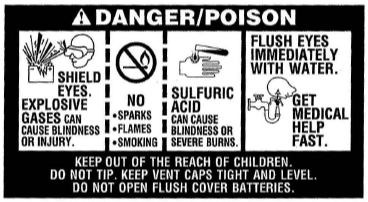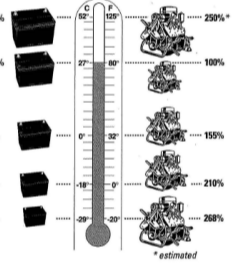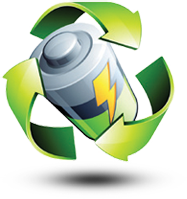" We 've got it !"
Battery Care and Maintenance
-
Can I install the battery myself?
Wear safety glasses. Special care must be taken when installing a battery to avoid a
serious explosion or accident.
If available, a computer memory saver should be used to save the vehicle's memory and avoid having to reprogram. Follow the manufacturer's directions carefully to avoid damageto the computer and/or electrical system.
1.Mark the positive (paS) cable. Turn off all electrical accessories. Disconnect hood and trunk bulb if opened to cut off all current.
2.Carefully remove old battery, disconnecting the ground cable first, to avoid any dangerous sparking around the battery.
3.Battery tray should be thoroughly cleaned and inspected for defects. Use a paste made from baking soda and water to neutralize any acid or corrosion. Repaint if necessary. It should be held fast to supporting members to prevent vibration and road shock. Replace tray if necessary.
4.The battery should rest level in the tray. Be sure terminals will clear hood, fender, etc.
5.The hold-down must be tightened until it is snug. Do not overtighten. Too much pressure on the battery case will cause damage to it internally and externally ... causing an acid leak.
6.Cable terminals should be brushed until shiny and spread wide so that they will slip over the battery post without force. Do not hammer on them. Be sure marked pas cable is connected to pas (+) terminal. Connect NEG (-) cable last to prevent dangerous sparks. DO NOT OVERTIGHTEN/ It's a good idea to installspecial corrosion retarding fiberwashers around terminals to help extend battery life.
7.Side terminal batteries need special care. Overtightening the terminal bolts will severely damage the battery and could cause a dangerous explosion. Use aspecial side terminal torque tool to avoid this hazard.
8.Coat the terminals and exposed metal parts around the battery with a goodquality protective spray.
-
How do I jumpstart a battery safely?
Shield eyes and face from batteries at all times! Be sure vent caps are tightand level. Place damp cloth over vent caps on both batteries. Be sure vehicles or cable ends do not touch. Use a good quality booster cable set.
BE CAREFUL !!
WARNING: Batteries produce explosive gases. Keep sparks, flames and cigarettes away from batteries at all times.
Protect your eyes at all times. Never lean over battery when jump starting orperforming other maintenance. Remember .•• always wear safety glasses whenworking around batteries!
-
How do I service my vehicle battery?
The first step to routinely servicing a battery is to make a visual inspection. Look for defective cables, loose connectors, corrosion, cracked cases or covers, loosehold-downs, and deformed or loose terminal posts. Remember. .. always
wear safety glasses.
Remove and replace a battery at once if there are cracks in cover or case. Place the leaking battery in a plastic bag and take it to a battery seller for proper recycling. ,
To remove corrosion and dirt from terminal posts, hold downs, tray or hold-down parts,scrape or brush it off. Use a corrosion removing spray or immerse the part in an alkaline solution such as baking soda in the proportions of one pound to a gallon of water. The corrosion is neutralized when the solution stops bubbling.Wash the part with water, dry, replace and apply a prepared corrosion protection spray.
-
What should I know when charging my battery?
Leave vent caps in place while charging to avoid explosion.
Batteries should be charged if hydrometer reading is below 1.225 SG, or 12.4 open circuit voltage, or the load test is below 9.6 volts.
Do not leave a battery on charge for more than 48 hours.
Stop the charge when two hydrometer or voltage readings recorded two hours apart indicate no increase.Further charging would be useless and may damage the battery and shorten its life.
If the battery won't come up to full charge, replace it.
If violent gassing or spewing ofelectrolyte occurs, or the battery case feels hot, reduce or temporarily haltcharging to avoid damaging the battery.
NEVER attempt to charge a frozen battery! Allow it to warm to 60°F (15.5°C) beforeplacing on charge. Otherwise a dangerous explosion can occur.
NEVER leave abattery on a trickle charger longer than 48 hours. Otherwise, serious damagewill occur.
ALWAYS leave vent caps in place to avoid explosion.
-
How do I check my charging system?
The voltage regulator should be checked every 10,000 miles or every time you change oil. It should be checked immediately if the battery is hot to the touch, if electrolyte is bubbling or spewing from the vents, if your hydrometer reading is below 1.225 or above 1.300, or if the open circuit voltage is below 12.4 volts or above12.9 volts. Overcharging is evident by excessive water consumption and/or spewing or bubbling of electrolyte out ofthe vents. Undercharging is 'evidentby slow cranking or lights dimming at idle.
-
How do I check the state of the battery charge?
There are two styles of battery ... non-accessible maintenance-free types and accessible maintainable types with removable vent caps.
Before adding water to amaintainable battery, take an open circuit voltage reading and/or hydrometer reading of one cell. Use a differentcell each time. If the readings are above 75%, the battery isfine. If the readings are below 75%, charge the battery. If the electrolyte level is too low to read with a hydrometer, addwater and take the hydrometer reading the following day, after the vehicle has been driven and the water has had an opportunity to mix. Check electrolyte levels in all cells. If necessary, add only clear, odorless drinkingwater to bring the liquid level to the level indicator or to 1/2" (13mm) above the top of the separators. Distilled water is preferred, especially if the water in your area has high iron. Do not overfill any cells. Excess electrolyte may be forced from an overfilled cell and cause corrosion on adjacent metalparts, reduce performance, and shorten life. In cold weather, do not fill cells with water and let stand without running engine or driving the vehicle long enough to allow water to mix with acid. Otherwise, freezing might occur and thebattery may crack or explode.
Maintenance-free,non-accessible batteries are designed to eliminate the need to add water. Yet the volume of electrolyte above plates may eventually become depleted due to abnormal conditions such as high heat or improper regulator setting. Use a voltmeter to check the state of charge.
See chart under"CHARGING TIPS" to determine if charging is necessary. DO NOT OPEN FLUSH COVER BATTERIES! If opened, serious personal injury can result and warranty will be voided.
Always Load Test
Follow-up your hydrometer or open circuit voltage test with an adjustable load test to determine if the battery has adequate electrical performance. Follow the instructions on the tester or ask your favorite service facility to load test your battery. If the battery maintains a minimum "on load" voltage of 9.6 volts for 30 seconds, it is in good condition. If not, recharge and load test again. If it fails a second time, REPLACE THE BATTERY IMMEDIATELY. Remember to keep sparks and flames away. ALWAYS
WEAR EYE PROTECTlON when working around batteries.
-
What battery size should I choose?
Always select a battery that has enough cranking power and reserve capacity to get the job done. Consider the vehicle manufacturer's recommended capacity to be aminimum capacity guideline.
Along with electrical accessories, temperature also has a dramatic effect on battery performance. Vehicles that are operated in extremely cold climates will need a battery
that's rated well above the minimum a.E. recommendation. Remember, you can't select a battery with too much power!
Temperaturehas a dramatic effect on a battery's ability to crank an engine. Not only does cold rob batteries of power, it also stiffens motor oil, making engines harderto start. And heat can damage batteries by causing internal components to wearout quickly while also making engines difficult to start. So do yourself afavor, select the higher capacity, more powerful batteries you'll need totackle demanding climate.
-
Why do vehicle batteries go dead while sitting?
Today’s vehicles discharge faster than ever and even a strong battery can go dead in as little as a week or two if left without running. Computers, relays, and sensors stay on while the vehicle is idle causing a parasitic drain. We recommend using a battery maintainer to keep the charge if you aren’t using your vehicle for a while. Smart chargers or battery maintainers are inexpensive and The Battery Man sells them from as low as $40.00.
-
How do I handle Lithium batteries?
• Exercise caution when handling and testing lithium-ion batteries.
• Do not short-circuit, overcharge, crush, drop, mutilate, penetrate with foreign objects, apply reverse polarity, expose to high temperature or disassemble packs and cells.
• Use only lithium-ion cells with a designated protection circuit and approved charger.
• Discontinue using the battery and/or charger if the pack temperature rises more than 10ºC (18ºF) on a regular charge.
• The electrolyte is highly flammable and battery rupture can cause physical injury.
• Use a foam extinguisher, CO2, dry chemical, powdered graphite, copper powder or soda (sodium carbonate) to extinguish a lithium-ion fire. Only pour water to prevent the fire from spreading.
• If the fire of a burning lithium-ion battery cannot be extinguished, allow the pack to burn out on its own in a controlled and safe manner.
-
How do I properly store batteries?
• Primary batteries store well. Alkaline and primary lithium batteries can be stored for 10 years with moderate loss capacity.
• When storing, remove the battery from the equipment and place in a dry and cool place.
• Avoid freezing. Batteries freeze more easily if kept in discharged state.
• Charge lead acid before storing and monitor the voltage or specific gravity frequently; apply a charge if below 2.07V/cell or if SG is below 1.225 (most starter batteries).
• Nickel-based batteries can be stored for 3–5 years, even at zero voltage; prime before use.
• Lithium-ion must be stored in a charged state, ideally at 40 percent. This prevents the battery from dropping below 2.50V/cell, triggering sleep mode.
• Discard Li-ion if kept below 2.00/V/cell for more than a week. Also discard if the voltage does not recover normally after storage.
-
What to do when a Battery overheats
If a Li-ion battery overheats, hisses or bulges, immediately move the device away from flammable materials and place it on a non-combustible surface. If at all possible, remove the battery and put it outdoors to burn out. You may also put the device outside and keep it there of a least 6 hours.
A small Li-ion fire can be handled like any other combustible fire. For best result use a foam extinguisher, CO2, ABC dry chemical, powdered graphite, copper powder or soda (sodium carbonate). Halon is also used as fire suppressant.
FAA instructs flight attendants to use water or soda pop to extinguish a fire in the cabin. Water-based products are most readily available and are appropriate since Li-ion contains very little lithium metal that reacts with water. Water also cools the adjacent area and prevents the fire from spreading. Research laboratories and factories use water to extinguish small Li-ion fires.
A large Li-ion fire, such as an EV, may need to burn out as water is ineffective. Water with copper material can be used, but this may not be available and is costly for fire halls. When encountering a fire with a lithium-metal battery, only use a Class D fire extinguisher. Lithium-metal contains lithium that reacts with water and makes the fire worse. Only use the Class D fire extinguisher on lithium fires.
CAUTION: Do not use a Class D fire extinguisher to put out other types of fires; make certain regular extinguishers are also available. With all battery fires, allow ample ventilation while the battery burns itself out.


At The Battery Man, “We’ve Got It!” And if we don’t have it “We’ll Get it”.
And if we can’t get it…”We’ll Make It”!

